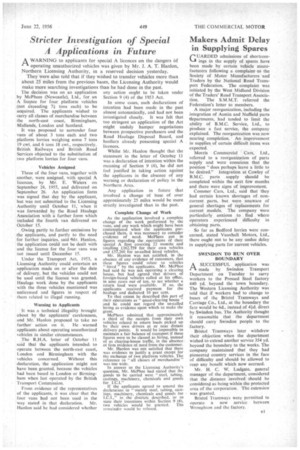Stricter Investigation of Special A Applications in Future
Page 35

If you've noticed an error in this article please click here to report it so we can fix it.
A WARNING to applicants for special A licences on the dangers of " operating unauthorized vehicles was given by Mr. J. A. T. Hanlon, Northern Licensing Authority, in a reserved decision yesterday.
They were also told that if they wished to transfer vehicles more than about 25 miles from the previous bases, the Licensing Authority would make more searching investigations than he had done in the past.
It was proposed to surrender four vans of about 3 tons each and two platform lorries weighing some 7 tons 19 cwt. and 6 tons 18 cwt., respectively. British Railways and British Road Services objected to the substitution of two platform lorries for four vans.
Vehicles Assigned Three of the four vans, together with another, were assigned, with special A licences, by Mr. E. Waters on September 24, 1955, and delivered on September 26. An application form was signed that day by the applicant, but was not submitted to the Licensing Authority until October 11, when it was forwarded by the Road Haulage Association with a further form which included the fourth van delivered on October 15.
Owing partly to further omissions by the applicants, and partly to the need for further inquiries, said 'Mr. Hanlon, the application could not be dealt with and the licence for the four vans was not issued until December 15.
Under the Transport Act, 1953, a Licensing Authority could entertain an application made on or after the date of delivery, but the vehicles could not be used until the licence was granted. Haulage work done by the applicants with the three vehicles mentioned was unlicensed and figures in respect of them related to illegal running.
Warning to Applicants It was a technical illegality brought about by the applicants' carelessness, and Mr. 'Hanlon proposed to take no further action on it. He warned applicants about operating unauthorized vehicles in similar circumstances.
The R.H.A. letter of October 11 said that the applicants intended= to operate between the north-east coast, London and Birmingham with the vehicles concerned. Without this declaration, the application might not have been granted, because the vehicles had been based in London or Birmingham when last operated by the British Transport Commission.
From evidence of the representatives of the applicants, it was clear that the four vans had not been used in the way stated in that declaration. Mr. Hanlon said he had considered whether In some cases, such declarations of intention had been made in the past almost automatically, and had not been investigated closely. It was felt that too stringent an application of the Act might unduly hamper negotiations between prospective purchasers and the Road Haulage Disposal Board, and hauliers already possessing special A licences.
Whilst Mr. Hanlon thought that the statement in the letter of October 11 was a declaration of intention within the meaning of Section 9 (4), he did not feel justified in taking action against the applicants in the absence of any warning or declaration of policy in the Northern Area.
Any application in future that involved a change of base of over approximately 25 miles would be more strictly investigated than in the past.
Complete Change of Work As the application involved a complete change of the work performed by the vans, and any work which might have been contemplated when the applicants purchased them, it was necessary to consider evidence of need. MePhees pot in figures regarding the operations of their special A fleet covering 22 months and totalling £162,759 for their own vehicles and £57,260 for so-called hired vehicles.
Mr. Hanlon was not satisfied, in the absence of any evidence of customers, that these figures could relate to vehicles " hired ' by the applicants. Mr. McPhee had said he was not operating a clearing house, but had agreed that drivers of foreign-based vehicles called at his office, in nine cases out of ten, to see whether a return load were available. If so, the applicants received payment for the haulage and deducted 10 per cent.
To that extent he described this part of their operations as " quasi-clearing house" and he could not regard the so-called hiring as evidence upon which to make the grant.
MePhees admitted that approximately a third of the receipts from their own vehicles related to return loads picked up by their own drivers at or near distant delivery points. It would be impossible to maintain a fair balance of transport if these figures were to be classed as hiring, instead of as clearing-house traffic, in the absence ol firm evidence of need from the customer.
Mr. Hanlon was not satisfied that there was evidence to justify a grant except for the exchange of two platform vehicles. The reference to "all classes of merchandise" was too wide.
In answer to the Licensing Authority's question, Mr. McPhee had stated that the goods to be carried were "steel, tubing, castings machinery, chemicals and goods for Lel."
If the applicants agreed to amend the declaration to "mainly steel, tubing, castings, machinery, chemicals and goods for I.C.I.," in the districts described, or to state their intentions within Section 9 (4). two vehicles would be granted. The remainder would be refused.




































































































